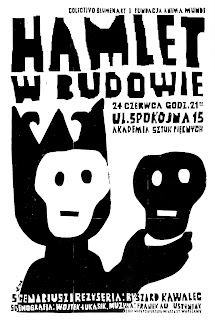Plakaty Krakow (2011), exhibition poster
- Graphic artist, painter, poster designer and illustrator
- In 1991, with Marek Sobczyk, set up the design company Zafryki, which produced amongst other things, illustrations for Magazyn Gazety Wyborczej, posters for the Variety Theater in Warsaw, graphic designs for books, logos and their own typefaces.
pg. 412 - 'Mlodozeniec and Sobczyk work in many areas of modern visual culture - involved in both art and design, they paint pictures, create animations and videos, and design posters and graphics, logos and corporate images.'
'They also design their own typefaces and while operating under the name Zafryki, they created dozens of them. They design all kinds of publications, do the covers and illustrations for them, and often themselves handle the layouts.'
pg. 414 - 'They treat typography with due deference, with texts and lettering undergoing numerous formal processes in order to beef up the impact of the message, whilst constantly looking for new, original solutions in terms of images.'
'Lettering most often interacts with the image provocatively, while creating a coherent whole. The distinctive Zafryki style is also simplicity and brevity.'
'In this conciseness of image and condensed visual language of simple forms, the artists leave plenty of room for viewer interpretation. Playing together with the recipient, with erudition, intelligence, and considerable experience in graphic signs and the latest trends on the street and in pop culture, they subtly insinuate concepts associated with high culture.'
1. Stach & Piotr Mlodozeniec Paintings (1977)
2. Prostokaty: Piotr Mlodozeniec i Pawel Szanajca (2012)
2. Prostokaty: Piotr Mlodozeniec i Pawel Szanajca (2012)
'Piotr Rypson wrote of Zafryki's activities as being the best that has happened in Polish graphic design since 1989. Stach Szablowski noted that in Zafryki's "applied arts", greater emphasis was always placed on the "art", and in this tendency saw the source of the duo's success.'
'Their careers began at a time of political turbulence with the formation of the Solidarity movement, followed by martial law. In that raised temperature of daily life, poverty and the mundane "problems of existence", important things were being said and done.'
pg. 415 - 'Hastily duplicated publications were hardly legible, blurred and unclear, but bore strong and important messages. In popular culture, punk was as its peak, and the very air was energised. In the art world, the tone was set by new rebels and a new expression.'
'These visual and audible stimuli only fuelled the restless mood even more and corresponded ideally with the realities.'
1. Hamlet under Construction (2006)
2. Giselle Ballet (1995)
2. Giselle Ballet (1995)
'In Polish art of the eighties, two artistic formations spoke with the loudest and bravest voice: Luxus and Gruppa. These artists used the irony and humour that throughout the years of socialism had allowed them to cheat the censor and live a little more freely.'
'Anecdote and narrative collided with the purely pictorial, and the artistic form of works evoked the avant-garde of the twentieth century, primitive art, graffiti, and the signs found in the city and everyday life.'
'Icons were simplified, powerful and expressive - for maximum communication.'
'Piotr Mlodozeniec, recalling this "underground" period of Poland in the eighties, emphasises how the then numerous limitations, not least the technological difficulties, influenced art:
"They certainly imposed a specific style. In my case it was a tendency to work in black and white, abandoning colour. Most of our work was carried out using the silk-screen printing technique, and sometimes by means of templates that were convenient and easy to prepare at home.
We used all kinds of ink, whatever we could get our hands on, such as Komfort washing paste mixed with printing inks. When you sneezed, half the print came away, but it had a certain charm.
These early technological experiments sometimes translated into something that can be called style: a striving for simplification, fun and games with templates. Later, even though the technology progressed, we kept returning to this method, as in a way it proved a productive medium and provided good effects."
'Afterimages of this iconography of revolution in the eighties mingled with the pixels of the cyber world. They were among the first Polish artists to take up the challenge of computer screen art.'
By creating we live (2005)







No comments:
Post a Comment